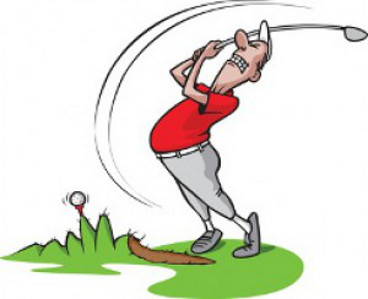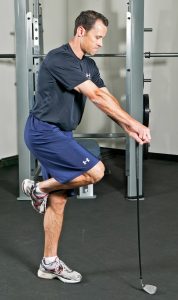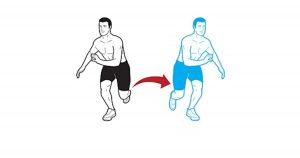Why is Balance Important for the Golf Swing
I’ll be blunt. If you have poor balance, it’s very unlikely that you will produce a repeatable and consistent golf swing. In every good golf swing there’s good balance. Poor balance leads to bad body control and weight shift in the golf swing. Generally, consistent golfers do a great job shifting their weight to their trail leg in the backswing, and to their lead leg prior to impact. This weight shift pattern helps promote body stability in the swing. Bad balance will inhibit the golfer from successfully controlling their body and shifting the weight throughout the swing, leading to more swing flaws such as Loss of Posture, Early Extension, and Sway/Slide.

Test Your Balance!
At FitGolf Performance Centers, we use the Single Leg Balance Test as one way to determine if a golfer is at risk of poor weight shift and swing flaws. As a golfer, you should test your balance. Here’s how it’s done:
1. First make sure you have adequate floor space with no objects you can trip over nearby. This test must be performed without shoes or sneakers.
2. Stand tall with your feet together, arms straight by your side, with your palms facing forward.
3. Slowly lift your right foot off of the floor and position the right leg so that both your hip and knee are at 90 degrees. Your knee should be directly i front of your hip, and your heel should be directly underneath your knee.
4. When you feel balanced and stable, close your eyes and begin to count. Hold the position as long as you can. Take note of your time and repeat on the other side.
If you were able to hold the single leg position with your eyes closed for 16 seconds, you passed. If you couldn’t make it to 16 seconds, you failed, implying that your balance, or lack thereof, could negatively impact your swing and make you a less consistent ball striker.

So You Failed the Balance Test...Now What?
Based off of my experience, most golfers fail the test the first time for reasons spanning wide, including poor leg, hip, and core strength, and/or poor proprioception. Proprioception is defined as, “A sense or perception, usually at a subconscious level, of the movements and position of the body and especially its limbs, independent of vision”. Unforunately, as we age, proprioception deteriorates. This means that in order to maintain a consisten golf swing, the golfer must physically train to maintain and improve their proprioception.
Here are three balance exercise progressions to improve your proprioception and golf swing:
1. SINGLE LEG BALANCE
This exercise is very simple, yet effective for beginners. Start by getting into a tall stable posture and stand on one leg. Once stable, try to balance yourself first with eyes open, and then eyes closed. Before closing your eyes, you should be able to hold the single leg stance with your eyes open for 20-30 seconds. Perform 3-4 sets on each leg and hold the stance for as long as you can. Once you’re proficient in the Single Leg Balance exercise, progress to Stork Turns.
2. STORK TURNS SUPPORTED/UNSUPPORTED
Using a golf club for support, pick up your right foot so you’re fully weight bearing on your left leg. Now, turn your lower body to the left to create a “pivot” in the left hip joint. Make sure you keep your chest facing forward as your hips rotate. Perform 3-4 sets x 10-15 reps each side. When you can perform 10-15 reps without losing your balance, place the golf club to the side and perform the Stork Turn Unsupported. (Tip: When you rotate your hips, focus on keeping your weight on the inside of the foot you are turning towards.) Once you can perform Stork Turns Unsupported without losing your balance, progress to Lateral Bounding

The subject would now turn his lower body to the left.
3. LATERAL BOUNDING
Get into a golf like posture and stand on your right leg only. Now jump to the side so you land on your left leg. Make sure you maintain your balance and the posture before jumping back to your right leg. The wider the jump is, the harder it will be to maintain your balance. Start with very narrow jumps and get wider as you improve. The width and speed of the jump is more important that the height of the jump. This exercise will not only help learn to accelerate and shift your weight, but also how to control the body and decelerate (just as important!) in the golf swing.

Keep at it!
Balance exercises can be very frustrating, but be persistent! The more time you put into working on your balance, the more consistent of a golfer you will be. If you have any questions about how your balance affects your golf swing, or about the balance exercises above, please feel free to email us directly or leave a comment below!
If you try these exercises and you find them to be too challenging or uncomfortable, do not continue, until you have consulted with your physician. All exercises for golf should be customized to your needs after a proper evaluation.
Come In and See Us
Want to take your golf to the next level? Our FitGolf® Trainers are experts at working one-on-one with you to tailor a training program to meet the specific needs of your body and help you achieve the results you are hoping to see in your golf.
Want More Resources?
Looking for more exercise resources, blog posts or monthly golf-specific exercise content sent straight to your inbox?
